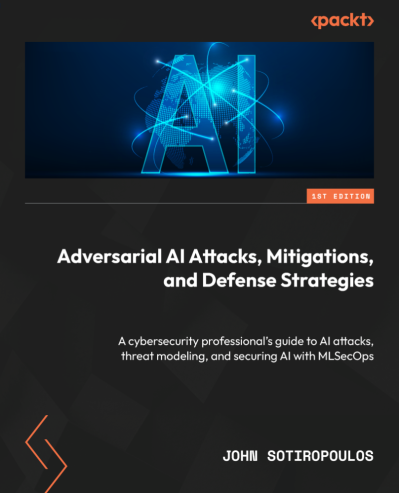Most Commented
Adversarial AI Attacks, Mitigations, and Defense Strategies: A cybersecurity profe...




Description material

epub | 34.22 MB | English | Isbn:9781835088678 | Author: John Sotiropoulos | Year: 2024
About ebook: Adversarial AI Attacks, Mitigations, and Defense Strategies: A cybersecurity professional's guide to AI attacks, threat modeling, and securing AI with MLSecOps
Understand how adversarial attacks work against predictive and generative AI, and learn how to safeguard AI and LLM projects with practical examples leveraging OWASP, MITRE, and NIST
Key Features
Understand the connection between AI and security by learning about adversarial AI attacks
Discover the latest security challenges in adversarial AI by examining GenAI, deepfakes, and LLMs
Implement secure-by-design methods and threat modeling, using standards and MLSecOps to safeguard AI systems
Purchase of the print or Kindle book includes a free PDF eBook
Book Description
Adversarial attacks trick AI systems with malicious data, creating new security risks by exploiting how AI learns. This challenges cybersecurity as it forces us to defend against a whole new kind of threat. This book demystifies adversarial attacks and equips cybersecurity professionals with the skills to secure AI technologies, moving beyond research hype or business-as-usual strategies. The strategy-based book is a comprehensive guide to AI security, presenting a structured approach with practical examples to identify and counter adversarial attacks. This book goes beyond a random selection of threats and consolidates recent research and industry standards, incorporating taxonomies from MITRE, NIST, and OWASP. Next, a dedicated section introduces a secure-by-design AI strategy with threat modeling to demonstrate risk-based defenses and strategies, focusing on integrating MLSecOps and LLMOps into security systems. To gain deeper insights, you'll cover examples of incorporating CI, MLOps, and security controls, including open-access LLMs and ML SBOMs. Based on the classic NIST pillars, the book provides a blueprint for maturing enterprise AI security, discussing the role of AI security in safety and ethics as part of Trustworthy AI. By the end of this book, you'll be able to develop, deploy, and secure AI systems effectively.
What you will learn
Understand poisoning, evasion, and privacy attacks and how to mitigate them
Discover how GANs can be used for attacks and deepfakes
Explore how LLMs change security, prompt injections, and data exposure
Master techniques to poison LLMs with RAG, embeddings, and fine-tuning
Explore supply-chain threats and the challenges of open-access LLMs
Implement MLSecOps with CIs, MLOps, and SBOMs
Who this book is for
This book tackles AI security from both angles - offense and defense. AI builders (developers and engineers) will learn how to create secure systems, while cybersecurity professionals, such as security architects, analysts, engineers, ethical hackers, penetration testers, and incident responders will discover methods to combat threats and mitigate risks posed by attackers. The book also provides a secure-by-design approach for leaders to build AI with security in mind. To get the most out of this book, you'll need a basic understanding of security, ML concepts, and Python.
Key Features
Book Description
Adversarial attacks trick AI systems with malicious data, creating new security risks by exploiting how AI learns. This challenges cybersecurity as it forces us to defend against a whole new kind of threat. This book demystifies adversarial attacks and equips cybersecurity professionals with the skills to secure AI technologies, moving beyond research hype or business-as-usual strategies. The strategy-based book is a comprehensive guide to AI security, presenting a structured approach with practical examples to identify and counter adversarial attacks. This book goes beyond a random selection of threats and consolidates recent research and industry standards, incorporating taxonomies from MITRE, NIST, and OWASP. Next, a dedicated section introduces a secure-by-design AI strategy with threat modeling to demonstrate risk-based defenses and strategies, focusing on integrating MLSecOps and LLMOps into security systems. To gain deeper insights, you'll cover examples of incorporating CI, MLOps, and security controls, including open-access LLMs and ML SBOMs. Based on the classic NIST pillars, the book provides a blueprint for maturing enterprise AI security, discussing the role of AI security in safety and ethics as part of Trustworthy AI. By the end of this book, you'll be able to develop, deploy, and secure AI systems effectively.
What you will learn
Who this book is for
This book tackles AI security from both angles - offense and defense. AI builders (developers and engineers) will learn how to create secure systems, while cybersecurity professionals, such as security architects, analysts, engineers, ethical hackers, penetration testers, and incident responders will discover methods to combat threats and mitigate risks posed by attackers. The book also provides a secure-by-design approach for leaders to build AI with security in mind. To get the most out of this book, you'll need a basic understanding of security, ML concepts, and Python.
Warning! You are not allowed to view this text.
Warning! You are not allowed to view this text.
Join to our telegram Group
Information
Users of Guests are not allowed to comment this publication.
Users of Guests are not allowed to comment this publication.
Choose Site Language
Recommended news
Commented



![eM Client Pro 9.2.1735 Multilingual [Updated]](https://pikky.net/medium/wXgc.png)






![Movavi Video Editor 24.0.2.0 Multilingual [ Updated]](https://pikky.net/medium/qhrc.png)

